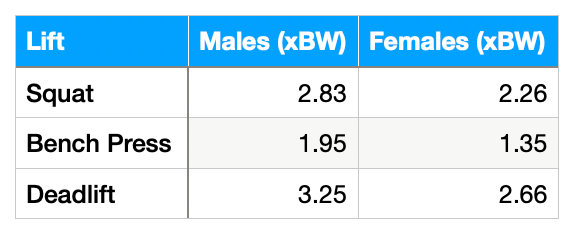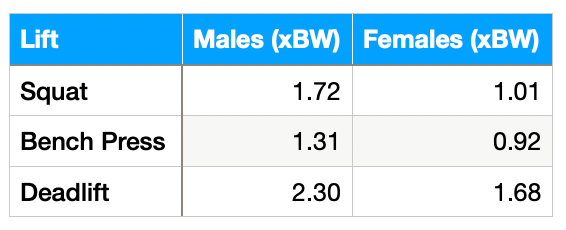Normative Data For the Squat, Bench Press and Deadlift in Powerlifting
Retrospective data from 809,986 global drug-tested, unequipped powerlifting competitions entries.
Have you ever wondered how your squat, bench press, or deadlift stacks up against the world’s best drug-tested lifters—at your age and weight? For anyone who lifts, knowing where you stand can be a game-changer for motivation, programming, and long-term progress. This comprehensive study finally provides the most accurate and up-to-date strength standards for powerlifters, covering all ages and body weights.
PMID: 39060209
Summary
Aim:
To create modern, detailed strength norms for the squat, bench press, and deadlift, using nearly 810,000 entries from drug-tested, unequipped powerlifting competitions worldwide.
Why it matters:
Previous strength standards were outdated, based on small or untrained populations, and didn’t reflect what trained lifters can achieve—especially for the deadlift and across different ages.
Key Points
Data Source: 809,986 competition entries (571,650 males, 238,336 females) from global, drug-tested, unequipped powerlifting meets (1968–2022).
Strength Measurement: All lifts expressed relative to bodyweight (e.g., how many times your bodyweight you can lift).
Categories: Results broken down by sex, age group (adolescent to 80+), and competitive weight class.
Percentiles: Norms provided for the 10th–90th percentile, so you can see how you compare to everyone from beginners to elites.
Aim
To establish accurate, contemporary strength norms for the squat, bench press, and deadlift in drug-tested, unequipped powerlifters, and to make these benchmarks available for lifters, coaches, and researchers.
Methods
Design: Retrospective cross-sectional analysis.
Data Collection: Results from all global, drug-tested, unequipped powerlifting competitions (openpowerlifting.org).
Participants: Anyone aged 12+ who competed in these meets.
Variables: Maximum successful squat, bench press, deadlift; age; sex; bodyweight; competition weight class.
Analysis: Relative strength (lifted weight ÷ bodyweight), with percentiles calculated for each group (age, sex, weight class).
Results
1. Age Trends
Peak Strength: Highest relative strength in young adults (18–35 years).
Decline with Age: Strength decreases steadily after age 35, but even lifters 80+ show impressive numbers compared to the general population.
Table 3 & 4: Strength Norms by Age
Table 3: 90th Percentile Relative Strength (Young Adults)

Table 4: Very Old Adults (80+ years, 90th percentile)

2. Weight Class Trends
Lighter Lifters: Highest relative strength (e.g., 59 kg males, 47 kg females).
Heavier Lifters: Relative strength drops as bodyweight increases, but absolute weights lifted are higher.
3. Sex Differences
Males have higher relative strength than females at every age and weight class, but top female lifters are still exceptionally strong relative to bodyweight.
Practical Takeaways
Benchmark Yourself: Use these norms to see how your lifts compare to drug-tested powerlifters of your age, sex, and weight class.
Goal Setting: Realistic, data-driven targets for each lift—whether you’re aiming for the 50th, 70th, or 90th percentile.
Programming: Adjust expectations and training plans as you age; peak relative strength is typically in young adulthood.
Talent ID: Coaches can spot potential by comparing athletes to these age- and weight-specific norms.
Online Tool: Instantly compare your lifts at www.thestrengthinitiative.com.
Key Takeaways
This is the largest, most accurate set of strength norms for powerlifters ever published.
Relative strength peaks in young adulthood and declines with age, but trained lifters remain strong well into old age.
Lighter lifters show higher relative strength; heavier lifters lift more in absolute terms.
These norms are a gold standard for benchmarking in strength sports—use them to guide your training, goal setting, and athlete development.
Bottom line:
If you want to know where you stand—or where you could be—compared to the best drug-tested lifters worldwide, this study gives you the clearest picture yet. Plug your numbers into the free calculator and see how you stack up!
Reference
van den Hoek DJ, Beaumont PL, van den Hoek AK, Owen PJ, Garrett JM, Buhmann R, Latella C. Normative data for the squat, bench press and deadlift exercises in powerlifting: Data from 809,986 competition entries. J Sci Med Sport. 2024 Oct;27(10):734-742. doi: 10.1016/j.jsams.2024.07.005. Epub 2024 Jul 11. PMID: 39060209.
You can also find me at dannyleejames.com for more personal stories, training advice and coaching.






